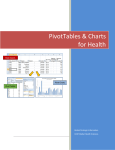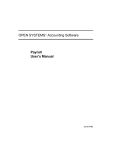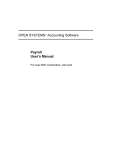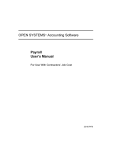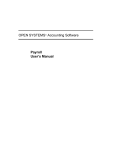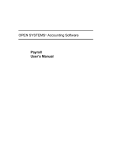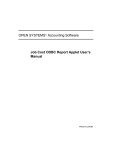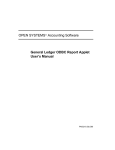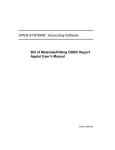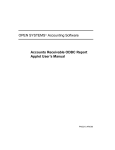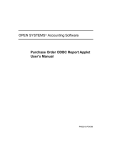Download PA - White Ware, Inc
Transcript
Payroll User’s Manual PN/2210.PAO60 OPEN SYSTEMS Accounting Software Payroll ODBC Report Applet User’s Manual PN/2210.PAO60 © 1998 Open Systems Holdings Corp. All rights reserved. Document Number 2210.PAO600 No part of this manual may be reproduced by any means without the written permission of Open Systems Holdings Corp. OPEN SYSTEMS is a registered trademark and OSAS, Resource Manager, Resource Manager for Windows, and Report Writer are trademarks of Open Systems Holdings Corp. BBx is a trademark and PRO/5 and Visual PRO/5 are registered trademarks of BASIS International Ltd. Novell, NetWare, and UNIXWare are registered trademarks of Novell, Inc. Microsoft, Microsoft Access, Microsoft Windows, Microsoft Windows 95, Windows, MS-DOS and PivotTable are either trademarks or registered trademarks of Microsoft Corporation. Crystal Reports for Windows is a trademark of Seagate Software, Inc. TrueType is a registered trademark of Apple Computer, Inc. Printed in U.S.A. August 1998, Release 6.0 This document has been prepared to conform to the current release version of OPEN SYSTEMS Accounting Software. Because of our extensive development efforts and our desire to further improve and enhance the software, inconsistencies may exist between the software and the documentation in some instances. Call your customer support representative if you encounter an inconsistency. Payroll Report Applet User’s Manual Contents Contents Introduction General Information Payroll Data Files Introduction to PivotTables Creating Microsoft Excel PivotTables 1-3 1-5 1-11 1-13 Installation 2-1 PA Checks PA Checks PA Check Deductions PA Check Earnings PA Check History PA Check Withholdings PA Department Analysis PA Employee History PA Employee Deduction History PA Employee Earnings History PA Employee Withholding History PA Leave History 3-3 3-5 3-7 3-9 3-15 3-17 3-21 3-25 3-27 3-31 3-35 Payroll Report Applet User’s Manual iii PA Recurring Deductions PA Recurring Time Tickets PA Miscellaneous Deduction History PA Time Ticket History 3-37 3-39 3-41 3-43 Index iv Payroll Report Applet User’s Manual Introduction 1 Payroll Report Applet User’s Manual General Information Payroll Data Files Introduction to PivotTables Creating Microsoft Excel PivotTables Payroll Report Applet User’s Manual 1-3 1-5 1-11 1-13 1-1 General Information The OPEN SYSTEMS Accounting Software (OSAS ) product line consists of several accounting applications. Each application addresses a different phase of your financial operations; together, they form a powerful accounting solution to your daily and periodic accounting needs. The ODBC Kit The OSAS ODBC Kit provides users with a way to access their OSAS data through any ODBC-compliant productivity package. The ODBC Kit includes an ODBC driver for Windows, the data dictionaries for the OSAS data files, utilities for maintaining the data dictionaries and some sample reports in Microsoft Excel, Microsoft Access and Crystal Reports for Windows. The Report Applets Since the release of the ODBC Kit, OSAS users have been discovering the power of these popular productivity packages to analyze their accounting data. The Report Applets provide a series of pre-built Microsoft Excel PivotTables to help you get the most from your accounting data. These tables are provided for each of the major data files in each application. This manual includes instructions for loading and using these spreadsheets to sort and analyze your data. With a little practice, you can easily create similar PivotTables or modify the ones provided to customize them to your exact needs. Payroll Report Applet User’s Manual 1-3 Payroll Data Files You use the Payroll system to automatically figure employee wages; federal, state, and local withholdings; and deductions. The Payroll system also tracks bonus pay and sick and vacation time and accumulates information for tax reporting. Finally, use the Payroll system to produce paychecks, reports, and employee W-2 forms. Payroll Data Files The Payroll Report Applet contains several spreadsheets that report information from the OSAS Payroll data files. The PivotTables in the PA Report Applet are based on these data files: PAEGxxx The Payroll Employee General Information file holds employee information such as employee ID, name, social security number, address, and phone number, equal employment opportunity code, vacation and sick accrual codes, and earning code, department, group code, labor class, and payment type (hourly or salaried), salary and/or hourly pay rate, pay periods per year, job title, and accrued and taken sick and vacation time. Data from this file is displayed in the PA Check History (PACHKHST.XLS) PivotTable. PAEMxxx The Payroll Employee Miscellaneous History file stores miscellaneous historical information for each employee: weeks worked, allocated tips, cost of GTLI, DCB, 457 and non-457 plans for each month, advance EIC payments, uncollected Medicare, and other information. Data from this file is displayed in the PA Employee History (PAEMHST.XLS) PivotTable. Payroll Report Applet User’s Manual 1-5 Payroll Data Files Introduction PAEDxxx The Payroll Employee Deduction History file stores month-, quarter-, and year-to date information about each employee’s payroll deductions. Data from this file is displayed in the PA Employee Deduction History (PAEMPDED.XLS) PivotTable. PAEExxx The Payroll Employee Earnings History file stores month-, quarter-, and year-to date earnings and hours worked—both gross and net pay amounts. Data from this file is displayed in the PA Employee Earnings History (PAEMPERN.XLS) PivotTable. PAEWxxx The Payroll Employee Withholding History file stores month-, quarter- and year-to date information about each employee’s payroll withholdings. Data from this file is displayed in the PA Employee Withholding History (PAEMPWTH.XLS) PivotTable. PADPxxx The Payroll Departments file stores general information for each department you set up: each earning code for the department, the employer-paid withholding and deduction, and pieces totals and total hours for the department. Data from this file is displayed in the PA Department Analysis (PADEPTS.XLS) PivotTable. PADDxxx The Payroll Company Deductions file stores the payroll deduction codes and information relating to these codes, which you enter through the Payroll Deductions function. Data from this file is displayed in the PA Check Deductions (PACHKDED.XLS) and the PA Check History (PACHKHST.XLS) PivotTables. 1-6 Payroll Report Applet User’s Manual Introduction Payroll Data Files PAECxxx The Payroll Earnings Codes file stores information that you use when entering time tickets or manual checks. Each earning code includes a description, whether or not the earning code is included in net pay and fixed withholding, the earning type, the general ledger account number and the multiplier and add-to-base factor. Data from the Earnings Codes file is displayed in the PA Check Earnings (PACHKERN.XLS) and the PA Check History (PACHKHST.XLS) PivotTables. PAWIxxx The Payroll Withholding Codes file stores payroll information for federal, state, and local withholdings, which you enter through the Withholdings function. Each withholding has a description, a general ledger account number, a tax ID, and a fixed percentage (if appropriate); whether or not the withholding is employer-paid and the weeks worked limit are indicated. If the withholding is an employer-paid withholding, this file also holds the employer liability account. Data from the Withholdings Codes file is displayed in the PA Check Withholdings (PACHKWTH.XLS) and the PA Check History (PACHKHST.XLS) PivotTables. PACHxxx The Payroll Checks file stores information about the checks during a payroll check cycle. Data from the Checks file is used in the PA Checks (PACHECKS.XLS) PivotTable. PACDxxx The Payroll Checks Deductions file stores the deductions taken for each employee paycheck in the current payroll check cycle. Data from this file is displayed in the PA Check Deductions (PACHKDED.XLS) PivotTable. Payroll Report Applet User’s Manual 1-7 Payroll Data Files Introduction PACExxx The Payroll Checks Earnings file stores the earning codes for each employee paycheck in the current payroll check cycle. Data from this file is displayed in the PA Check Earnings (PACHKERN.XLS) PivotTable. PACWxxx The Payroll Checks Withholdings file stores the withholdings for each employee paycheck in the current payroll check cycle. Data from this file is displayed in the PA Check Withholdings (PACHKWTH.XLS) PivotTable. PARExxx The Payroll Recurring Entries file stores information about recurring time tickets. Data from this file is displayed in the PA Recurring Time Tickets (PAREEARN.XLS) and PA Recurring Deductions (PAREDED.XLS) PivotTables. PATHxxx The Payroll Transaction History file stores the time tickets and miscellaneous payroll entries you make through the Payroll Transactions function. Data from this file is displayed in the PA Time Ticket History (PATHEARN.XLS) and PA Miscellaneous Deduction History (PATHDED.XLS) PivotTables. PAHCxxx The Payroll Check History file stores general information (employee ID, department, check number) for each check you have disbursed for payroll expenses. Data from this file is displayed in the PA Check History (PACHKHST.XLS) PivotTable. PAHDxxx The Payroll Check Deductions History file stores a record of the deductions taken from each check you have disbursed for payroll expenses. Data from this file is displayed in the PA Check History (PACHKHST.XLS) PivotTable. 1-8 Payroll Report Applet User’s Manual Introduction Payroll Data Files PAHExxx The Payroll Check Earnings History file stores a record of the earnings associated with each check you have disbursed for payroll expenses. Data from this file is displayed in the PA Check History (PACHKHST.XLS) PivotTable. PAHWxxx The Payroll Check Withholdings History file stores a record of the withholdings associated with each check you have disbursed for payroll expenses. Data from this file is displayed in the PA Check History (PACHKHST.XLS) PivotTable. PAHVxxx The Payroll Leave Adjustment History file stores the positive and negative adjustments you make to an employee’s sick and vacation pay. Data from this file is displayed in the PA Check History (PACHKHST.XLS) PivotTable. Payroll Report Applet User’s Manual 1-9 Introduction to PivotTables A Microsoft Excel PivotTable is an interactive table that quickly summarizes, or cross-tabulates, large amounts of data. You can rotate its rows and columns to see different summaries of the source data, filter the data by displaying different pages, or display the details for areas of interest. A PivotTable contains fields, each of which summarizes multiple rows of information from the source data. By dragging a field button to another part of the PivotTable, you can view your data in different ways. For example, you can view any field either down the rows or across the columns. The PivotTable summarizes data by using a summary function, such as Sum, Count, or Average. You can include subtotals and grand totals automatically, or use your own formulas by adding calculated fields and items. In the Payroll Report Applet, several PivotTables are provided based on the data in the OSAS data files. The PivotTable is updated through the ODBC driver. The next section includes a tutorial for setting up and modifying PivotTables in Excel. Payroll Report Applet User’s Manual 1-11 Creating Microsoft Excel PivotTables Read this section for an exercise in creating a PivotTable using the ODBC Kit and Microsoft Excel 97. If you require more information about Microsoft Excel, consult the Microsoft Excel User’s Guide or Online Help. Before you can create this report, complete these tasks: • Install and set up the ODBC Kit. • Install and set up the BASIS ODBC drivers. • Install Microsoft Excel 97 and Microsoft Query 97. Note This section includes instructions for using Microsoft Query with Microsoft Excel. If necessary, you can install Microsoft Query from the Microsoft Office 97 media. You may also need to create a shortcut to Query manually. Payroll Report Applet User’s Manual 1-13 Creating Microsoft Excel PivotTables Introduction Building a Query For a PivotTable 1. Start Microsoft Query. 2. Under the File menu, select New. The Choose Data Source screen appears. 1-14 Payroll Report Applet User’s Manual Introduction Creating Microsoft Excel PivotTables 3. Select <New Data Source>, and click OK. The Create New Data Source screen appears. 4. Enter a name you want to give the data source in field 1. You can use the same source again. 5. Select the BASIS ODBC Driver in field 2. 6. Click Connect. The BASIS ODBC Driver Data Source Setup box appears. 7. Enter the file path and name of the CONFIG.TPM file you set up from within the OSAS ODBC software in the Database Configuration field, or select Browse and locate the file. Payroll Report Applet User’s Manual 1-15 Creating Microsoft Excel PivotTables Introduction If you have already built the shadow dictionary, click on the Advanced button, and check the options for No Shadow Dictionary Consistency Check and Fast Connect to improve performance. See online help for additional information about the options that come with the Advanced button. 8. Click OK to connect to the data source. You are returned to the Create New Data Source screen. 9. Select a table in field 4 if you want to select a default table source; otherwise, leave field 4 blank and select any table when you develop the query. (If you select a table, the list of tables always starts at that table; otherwise the list of tables starts at the beginning of the list.) The Choose Data Source box appears. 10. Select the data source you set up in the previous steps. 1-16 Payroll Report Applet User’s Manual Introduction Creating Microsoft Excel PivotTables The Choose Columns screen appears. 11. Select a table you want to use in your Excel spreadsheet. For this example, start with one table and add a second table later. Select the SOTH table, select the columns for the spreadsheet, and click Next >. The Filter Data box appears. Use the Filter Data dialog box to select specific records from the table. In most cases, you do not need to choose anything in the Filter Data dialog box. For example, to filter out credit memos, select the field named TRANSACTION_TYPE, select does not equal, and then enter 4 for a value. (TRANSACTION_TYPE 4 is a credit memo.) Payroll Report Applet User’s Manual 1-17 Creating Microsoft Excel PivotTables Introduction 12. Click Next >. The Sort Order box appears. Use the Sort Order dialog box to select how the data is sorted. For example, select a field in Sort by and check Ascending or Descending. Select more fields and orders for hierarchical sorts. For now, don’t enter any sort fields. 13. Click Finish. You are returned to the Microsoft Query screen. 1-18 Payroll Report Applet User’s Manual Introduction Creating Microsoft Excel PivotTables The data in your query is displayed. You can delete columns by selecting a column and pressing the Delete key. You can also add a column by doubleclicking on the field name (in the SOTH file). Note NOTE: You can also select which fields you want in your query in step 6 above. Instead of selecting the entire table, you can click the + box next to the table you want and select the given fields from the list. 14. Select the following fields: • • • • • • • • • BATCH_ID ORDER_NUMBER TRANSACTION_TYPE INVOICE_NUMBER INVOICE_DATE CUSTOMER_ID SUBTOTAL SALES_TAX TOTAL_COST 15. Select Table from the main menu, and choose Add tables. The Add Table dialog box appears. Payroll Report Applet User’s Manual 1-19 Creating Microsoft Excel PivotTables Introduction 16. A list of all the tables is displayed. Select the SOTD table, and click Close. Joining Tables 17. Locate BATCH_ID in the SOTD and SOTH tables; then click and hold the left mouse button down on BATCH_ID in the SOTH table 18. Drag the field over to the BATCH_ID field in the SOTD table and release the mouse button. A line appears between the two BATCH_ID fields, joining the two fields. 19. Follow steps 17 through 18 with the ORDER_NUMBER field. NOTE: You may get the following message. For now, click Yes to ignore the message and join the fields together. 20. Select the following fields from the SOTD table: • • • • • • ENTRY_NUMBER UNIT_COST_COMPNT UNIT_PRICE ORDERED_QTY SHIPPED_QTY_SELL BACKORDERED_QTY. 21. Select Save from the File menu to save the query. 1-20 Payroll Report Applet User’s Manual Introduction Creating Microsoft Excel PivotTables Using the Query in Microsoft Excel 1. Start Excel and open a new worksheet. 2. Select the Data menu; then select PivotTable Report. Payroll Report Applet User’s Manual 1-21 Creating Microsoft Excel PivotTables Introduction The PivotTable Wizard appears. 3. In step 1 of the Wizard, a list of options is displayed where you can choose your data source to be used in your PivotTable. Select External Data Source, and click Next >. The PivotTable Wizard Step 2 dialog box appears. 4. In step 2 of the Wizard, click Get Data. 1-22 Payroll Report Applet User’s Manual Introduction Creating Microsoft Excel PivotTables The Choose Data Source box from Microsoft Query appears. 5. Click the Queries tab, and select the query you saved under Microsoft Query. The Choose Columns box under Query appears. Payroll Report Applet User’s Manual 1-23 Creating Microsoft Excel PivotTables Introduction 6. Click Next >. The query columns are displayed. 7. Click Next > to pass by Filter Data and Sort Order options. The Query Wizard - Finish dialog box appears. 8. Select Return Data to Microsoft Excel, and click Finish. You are returned to the PivotTable Wizard Step 2 dialog box. 9. Click Next >. 1-24 Payroll Report Applet User’s Manual Introduction Creating Microsoft Excel PivotTables The PivotTable Wizard Step 3 dialog box appears. The selected fields and four areas—Page, Row, Column, and Data—to put fields are displayed. Drag and drop the fields to use in this report into the respective areas. (To display the full field name, hold the cursor on the button, and a tool tip displays the full field name.) 10. Drag and drop the following fields: • TRANSACTION_TYPE into Page • INVOICE_NUMBER, INVOICE_DATE, and ENTRY_NUM into Row • BATCH_ID into Column • ORDERED_QTY, SHIPPED_QTY_SELL, UNIT_COST_COMPNT and UNIT_PRICE into Data. Payroll Report Applet User’s Manual 1-25 Creating Microsoft Excel PivotTables Introduction The fields are displayed on the screen. Numeric fields dropped into the Data section become summary fields. 11. Click Next >. The PivotTable Wizard Step 4 dialog box appears. 12. The last step lets you create the PivotTable either in the existing worksheet or in a different worksheet. Accept the given options and click Finish. 1-26 Payroll Report Applet User’s Manual Introduction Creating Microsoft Excel PivotTables The PivotTable is displayed. Highlight rows and columns to shift them around. To display only invoices, change Transaction Type from All to 3. Change it to 4 and credit memos are displayed. Totals per type are also displayed. Adding a Calculated Field You can also add new fields, like profit, to the data area. To add profit to the data area, follow these steps: 1. Highlight the last row in your data area, Sum of UNIT_PRICE, right-click, and select Insert. Payroll Report Applet User’s Manual 1-27 Creating Microsoft Excel PivotTables Introduction The Insert Calculated Field dialog box appears. 2. Enter the following information about the inserted field: • Enter Profit Dollars in the Name field. • Enter =(SHIPPED_QTY_SELL* UNIT_PRICE) ( SHIPPED_QTY_SELL* UNIT_COST_COMPNT) in the Formula field. 3. Click Add. 1-28 Payroll Report Applet User’s Manual Introduction Creating Microsoft Excel PivotTables 4. Click OK. The PivotTable is displayed with the Sum of Profit Dollars field. Payroll Report Applet User’s Manual 1-29 Creating Microsoft Excel PivotTables Introduction Changing Field Properties You can also change the properties of the fields in the table. For example, to remove the subtotals from the INVOICE_DATE field: 1. Place your mouse cursor on the INVOICE_DATE column heading, right-click and select Field... from the menu. The PivotTable Field dialog box appears: You can use the PivotTable Field dialog box to change the field name, its orientation on the PivotTable, its display mask, subtotalling options and so on. 2. To shut of the subtotals, select None under Subtotals and click OK. 1-30 Payroll Report Applet User’s Manual Introduction Creating Microsoft Excel PivotTables The PivotTable is redisplayed reflecting your changes: Payroll Report Applet User’s Manual 1-31 Creating Microsoft Excel PivotTables Introduction Moving Fields and Sorting Data You can dramatically change the appearance of the table by moving the fields around. Fields appear on the PivotTable as gray blocks with the field name on them. To move any field, simply drag it to a new destination. You can change your PivotTable by moving fields in these ways: Changing the Selection Fields If you want to be able to limit the data in the table, you can make any field in the table part of the selection criteria by moving it to the Page area. For example, to select a specific batch for this table rather than displaying all the batches across the table columns as they are in our sample table, follow these steps: 1. Position the mouse cursor over the BATCH_ID field, press and hold the left mouse button. As you drag the BATCH_ID field around the table, the cursor changes to show where you can drop it. If the cursor looks like a block with an X over it, you will remove the field from the table by dropping it there. 2. Drag the BATCH_ID field to the left of the TRANSACTION_TYPE field and drop it there. 1-32 Payroll Report Applet User’s Manual Introduction Creating Microsoft Excel PivotTables The change appears immediately: Payroll Report Applet User’s Manual 1-33 Creating Microsoft Excel PivotTables Introduction Changing the Column Data You can change the data that appears in the columns in the table by dragging the fields or data block to the column heading area. For example, to show the quantity, price, cost and profit information in our table across the columns instead of in the data block as they now appear, drag the Data field above the Total column heading and drop it there. The change appears immediately: 1-34 Payroll Report Applet User’s Manual Introduction Creating Microsoft Excel PivotTables Changing the Data Sort To change the order in which the data is displayed, you can simply change the Row fields around. For example, our PivotTable is sorted by Invoice Number. To sort it by Invoice Date instead, click and drag the INVOICE_DATE field to the left of the INVOICE_NUMBER field. The data is sorted by Invoice Date and is redisplayed: You can also drag the selection fields from the Page area to the Row area to sort the data by those fields. Payroll Report Applet User’s Manual 1-35 Creating Microsoft Excel PivotTables Introduction More About Using PivotTables Feel free to experiment with the orientation of the fields on this sample report. As you become more familiar with the tables and how to use them, you can enjoy the benefits of viewing your data in new and different ways. For more information about PivotTables, see the Microsoft Excel documentation or online help. 1-36 Payroll Report Applet User’s Manual Installation 2 Payroll Report Applet User’s Manual You can put the Payroll ODBC Report Applet on your system by installing it through Resource Manager. The installation process is described in this section. The Payroll Report Applet needs a minimum of 295 kilobytes (295KB) for installation. You must also have installed Payroll and the ODBC Kit on your system, and the ODBC drivers on the Windows workstation. Installing the Report Applet Use the Install Application function on the Resource Manager Installation menu to install the report applet. You must install the Payroll application before you install this report applet. The installation will treat the report applet as though you are reinstalling Payroll. This is normal behavior. Note If you use Direct Deposit, you must install the applet for Direct Deposit in order to access the bank account and employee distribution information you enter. When you install the report applet, Resource Manager copies the PivotTables to the directory where your Payroll programs are stored. You must have access to this directory from your Windows machine to access the tables in Microsoft Excel. Payroll Report Applet User’s Manual 2-1 Installation The CONFIG.TPM File When you install the ODBC Kit, you specify the location of the data files and data dictionaries in a file called CONFIG.TPM. You can build this file using the ODBC Kit functions. You can store this file in any directory, but the report applets expect the file to be located in the C:\WINDOWS directory. If your CONFIG.TPM file is stored in a different directory, you have three choices for using the PivotTables supplied with the report applet: 1. Move the CONFIG.TPM file to the C:\WINDOWS directory and change any Data Sources you have set up and any ODBC reports or spreadsheets you have already set up to use the CONFIG.TPM in its new location. 2. Copy the CONFIG.TPM file to the C:\WINDOWS directory and leave a copy in its current location. You do not need to change any Data Sources or reports you have set up, but you need to make any changes in both files. 3. Change the PivotTables provided with this report applet to use the CONFIG.TPM file in its current location. You can find instructions for doing this below. If you choose methods 1 or 2 above, you can load the PivotTables in Microsoft Excel and begin using them with your data by using the Refresh Data command in Excel. If you choose option 3, follow the instructions below to point the PivotTable to the correct CONFIG.TPM file. 2-2 Payroll Report Applet User’s Manual Installation Using a Different CONFIG.TPM If you store your CONFIG.TPM file in a location other than the C:\WINDOWS directory, you will see this message when you attempt to refresh the data in any PivotTable included with this report applet: When you click on OK, the BASIS ODBC Driver Data Source Setup dialog box appears: To specify the location of your CONFIG.TPM file, click Browse and select the file from the location screen: Payroll Report Applet User’s Manual 2-3 Installation When you select the file, the final dialog appears: When you click on OK, the PivotTable is updated with your accounting data. Report Applet PivotTables Use the descriptions of the PivotTables in chapter 3 to work with your accounting data. 2-4 Payroll Report Applet User’s Manual Payroll PivotTables 3 Payroll Report Applet User’s Manual PA Checks PA Check Deductions PA Check Earnings PA Check History PA Check Withholdings PA Department Analysis PA Employee History PA Employee Deduction History PA Employee Earnings History PA Employee Withholding History PA Leave History PA Recurring Deductions PA Recurring Time Tickets PA Miscellaneous Deduction History PA Time Ticket History Payroll Report Applet User’s Manual 3-3 3-5 3-7 3-9 3-15 3-17 3-21 3-25 3-27 3-31 3-35 3-37 3-39 1-41 1-43 3-1 PA Checks File Name PACHECKS.XLS Description The PA Checks PivotTable uses the data in the Payroll Checks (PACHx) file to display information about the checks prepared in the current payday check cycle. The data is sorted by Sequence Number and Employee ID, but you can easily change the sort order. You can use this PivotTable to review the checks on file before printing and posting them. Active Fields Default Field Type Field Page (None) Row Sequence Number Employee ID Column Gross Pay Net Amount Hours Worked Total Pieces Payroll Report Applet User’s Manual 3-3 PA Checks Payroll PivotTables PA Checks PivotTable Sample 3-4 Payroll Report Applet User’s Manual PA Check Deductions File Name PACHKDED.XLS Description The PA Check Deductions PivotTable uses the data in the Checks Deductions (PACDx) file to display detailed deduction information from each employee paycheck. The report is sorted by Sequence Number, Deduction Code and Description, but you can easily change the sort order, or include the Employer Paid flag in the sort. You can use this PivotTable to review the deductions calculated in the current check run. Active Fields Default Field Type Field Page Employer Paid? flag Row Sequence Number Deduction Code Description Column Total Deduction Amount Payroll Report Applet User’s Manual 3-5 PA Check Deductions Payroll PivotTables PA Check Deductions PivotTable Sample 3-6 Payroll Report Applet User’s Manual PA Check Earnings File Name PACHKERN.XLS Description The PA Check Earnings PivotTable uses the data in the Checks Earnings (PACEx) file to display detailed earnings information from each employee paycheck. The report is sorted by Sequence Number, Earnings Code, State and Department ID, but you can easily change the sort order, or include the Employee ID in the sort. You can use this PivotTable to review the earnings calculated in the current check run. Active Fields Default Field Type Field Page Employee ID Row Sequence Number Earnings Code State Department ID Column Hourly Rate Hours Worked Amount Payroll Report Applet User’s Manual 3-7 PA Check Earnings Payroll PivotTables PA Check Earnings PivotTable Sample 3-8 Payroll Report Applet User’s Manual PA Check History File Name PACHKHST.XLS Description The PA Check History PivotTable uses the data in the Checks History (PAHCx), Check Earnings History (PAHEx), Check Deductions History (PAHDx) and Check Withholdings History (PAHWx) files to display detailed information about the paychecks you have disbursed in past payroll check cycles. The Check History PivotTable is made up of these related spreadsheets: Summary, Deductions, Earnings, and Withholdings. You can change between these sheets by selecting the appropriate tab at the bottom of the current sheet. The data is sorted by Sequence Number, but you can easily change the sort order. You can use this PivotTable to review any check that you have not purged from the history files. Payroll Report Applet User’s Manual 3-9 PA Check History Payroll PivotTables PA Check History–Summary Sheet Active Fields Default Field Type Field Page Check Type Employee ID Row Sequence Number Check Number Check Date Column Gross Pay Net Check Amount PA Check History–Summary PivotTable Sample 3-10 Payroll Report Applet User’s Manual Payroll PivotTables PA Check History PA Check History–Deductions Sheet Active Fields Default Field Type Field Page Employee ID Row Sequence Number Deduction Code Description Check Number Column Deduction Hours Deduction Amount PA Check History–Deductions PivotTable Sample Payroll Report Applet User’s Manual 3-11 PA Check History Payroll PivotTables PA Check History–Earnings Sheet Active Fields Default Field Type Field Page Employee ID Department ID Row Sequence Number Check Number Earnings Code Description Column Hours Worked Hourly Rate Earnings Amount PA Check History–Earnings PivotTable Sample 3-12 Payroll Report Applet User’s Manual Payroll PivotTables PA Check History PA Check History–Withholdings Sheet Active Fields Default Field Type Field Page Employee ID Employer Paid? flag Row Sequence Number Check Number Tax Authority Withholding Code Description Column Earnings Withholding Amount PA Check History–Withholdings PivotTable Sample Payroll Report Applet User’s Manual 3-13 PA Check Withholdings File Name PACHKWTH.XLS Description The PA Check Withholdings PivotTable uses the data in the Checks Withholdings (PACWx) and Withholding Codes (PAWIx) files to display detailed withholding information from each employee paycheck. The report is sorted by Sequence Number, Employee ID, Tax Authority, Withholding Code and Description, but you can easily change the sort order, or include the Employer Paid? flag in the sort. You can use this PivotTable to review the withholdings calculated in the current check run. Active Fields Default Field Type Field Page Employer Paid? flag Row Sequence Number Employee ID Tax Authority Withholding Code Description Column Earnings Withholding Amount Payroll Report Applet User’s Manual 3-15 PA Check Withholdings Payroll PivotTables PA Check Withholdings PivotTable Sample 3-16 Payroll Report Applet User’s Manual PA Department Analysis File Name PADEPTS.XLS Description The PA Department Analysis PivotTable uses the data in the Departments (PADPx) file to display historical totals of earnings, deductions and withholdings by department. The PA Department Analysis PivotTable consists of these related spreadsheets: Deductions, Earnings and Withholdings. You can change between these sheets by selecting the appropriate tab at the bottom of the current sheet. The data is sorted by Code, but you can easily change the sort order. Payroll Report Applet User’s Manual 3-17 PA Department Analysis Payroll PivotTables PA Department Analysis–Deductions Sheet Active Fields Default Field Type Field Page Department ID Row Deduction Code Description Column Period-, Quarter- and Year-to-Date Deduction Amounts PA Department Analysis–Deductions PivotTable Sample 3-18 Payroll Report Applet User’s Manual Payroll PivotTables PA Department Analysis PA Department Analysis–Earnings Sheet Active Fields Default Field Type Field Page Department ID Row Earnings Code Description Column Period-, Quarter- and Year-to-Date Earnings Amounts PA Department Analysis–Earnings PivotTable Sample Payroll Report Applet User’s Manual 3-19 PA Department Analysis Payroll PivotTables PA Department Analysis–Withholdings Sheet Active Fields Default Field Type Field Page Department ID Row Tax Authority Withholding Code Description Column Period-, Quarter- and Year-to-Date Withholding Amounts PA Department Analysis–Withholdings PivotTable Sample 3-20 Payroll Report Applet User’s Manual PA Employee History File Name PAEMHST.XLS Description The PA Employee History PivotTable uses the data in the Employee Miscellaneous History (PAEMx) file to display historical totals of hours and weeks worked for the employees you choose. The PA Department Analysis PivotTable consists of these related spreadsheets: Hours Worked and Weeks Worked. You can change between these sheets by selecting the appropriate tab at the bottom of the current sheet. Payroll Report Applet User’s Manual 3-21 PA Employee History Payroll PivotTables PA Employee History–Hours Worked Sheet Active Fields Default Field Type Field Page Employee ID Row (None) Column Total Hours Worked PA Employee History–Hours Worked PivotTable Sample 3-22 Payroll Report Applet User’s Manual Payroll PivotTables PA Employee History PA Employee History–Weeks Worked Sheet Active Fields Default Field Type Field Page Employee ID Row (None) Column Total Weeks Worked PA Employee History–Weeks Worked PivotTable Sample Payroll Report Applet User’s Manual 3-23 PA Employee Deduction History File Name PAEMPDED.XLS Description The PA Employee Deduction History PivotTable uses the data in the Employee Deduction History (PAEDx) file to display monthly and year-to-date deduction totals for the employees you choose. The report is sorted by Deduction Code and Description, but you can easily change the sort order to include the Employee ID. Active Fields Default Field Type Field Page Employee ID Row Deduction Code Description Column January-December Amounts Year-to-Date Amount Payroll Report Applet User’s Manual 3-25 PA Employee Deduction History Payroll PivotTables PA Employee Deduction History PivotTable Sample 3-26 Payroll Report Applet User’s Manual PA Employee Earnings History File Name PAEMPERN.XLS Description The PA Employee Earnings History PivotTable uses the data in the Employee Earnings History (PAEEx) file to display monthly and year-to-date hours and earnings for the employees and earnings code you choose. The PA Employee Earnings History PivotTable consists of these related spreadsheets: Hours and Earnings. You can change between these sheets by selecting the appropriate tab at the bottom of the current sheet. Payroll Report Applet User’s Manual 3-27 PA Employee Earnings History Payroll PivotTables PA Employee Earnings History–Hours PivotTable Active Fields Default Field Type Field Page Employee ID Earnings Code Row (None) Column Total Hours PA Employee Earnings History–Hours PivotTable Sample 3-28 Payroll Report Applet User’s Manual Payroll PivotTables PA Employee Earnings History PA Employee Earnings History–Earnings PivotTable Active Fields Default Field Type Field Page Employee ID Earnings Code Row (None) Column Total Earnings PA Employee Earnings History–Earnings PivotTable Sample Payroll Report Applet User’s Manual 3-29 PA Employee Withholding History File Name PAEMPWTH.XLS Description The PA Employee Withholding History PivotTable uses the data in the Employee Withholding History (PAEWx) file to display monthly and year-to-date earnings and withholdings amounts for the employees you choose. The PA Employee Withholding History PivotTable consists of these related spreadsheets: Earnings and Withholding. You can change between these sheets by selecting the appropriate tab at the bottom of the current sheet. Payroll Report Applet User’s Manual 3-31 PA Employee Withholding History Payroll PivotTables PA Employee Withholding History–Earnings PivotTable Active Fields Default Field Type Field Page Employee ID Employer Paid? flag Row Tax Authority Withholding Code Column January-December Earnings Year-to-Date Earnings PA Employee Withholding History–Earnings PivotTable Sample 3-32 Payroll Report Applet User’s Manual Payroll PivotTables PA Employee Withholding History PA Employee Withholding History–Withholding PivotTable Active Fields Default Field Type Field Page Employee ID Employer Paid? flag Row Tax Authority Withholding Code Column January-December Withholding Amounts Year-to-Date Withholding Amount Employee Withholding History–Withholding PivotTable Sample Payroll Report Applet User’s Manual 3-33 PA Leave History File Name PALVHST.XLS Description The PA Leave History PivotTable uses the data in the Leave Adjustment History (PAHVx) file to display adjusted and earned time for paid sick and vacation leave. The report is sorted by Earnings Code, Description, Check Number and Adjustment Date, but you can easily change the sort order or include the Employee ID or Sick/Vacation Flag in the sort. Active Fields Default Field Type Field Page Employee ID Sick/Vacation Flag Row Earnings Code Description Check Number Adjustment Date Column Adjustment Amount Payroll Report Applet User’s Manual 3-35 PA Leave History Payroll PivotTables PA Leave History PivotTable Sample 3-36 Payroll Report Applet User’s Manual PA Recurring Deductions File Name PAREDED.XLS Description The PA Recurring Deductions PivotTable uses the data in the Recurring Entries (PAREx) file to display detailed information about the recurring miscellaneous deductions you have set up. The report is sorted by Sequence Number, Deduction Code and Description, but you can easily change the sort order, or add the Employee ID to the sort. Active Fields Default Field Type Field Page Employee ID Row Sequence Number Deduction Code Description Column Hours Amount Payroll Report Applet User’s Manual 3-37 PA Recurring Deductions Payroll PivotTables PA Recurring Deductions PivotTable Sample 3-38 Payroll Report Applet User’s Manual PA Recurring Time Tickets File Name PAREEARN.XLS Description The PA Recurring Time Tickets PivotTable uses the data in the Recurring Entries (PAREx) file to display detailed information about the recurring time tickets you have set up. The report is sorted by Earnings Code, Description and Transaction Date, but you can easily change the sort order, or add the Employee ID to the sort. Active Fields Default Field Type Field Page Employee ID Row Earnings Code Description Transaction Date Column Hours Hourly Rate Amount Payroll Report Applet User’s Manual 3-39 PA Recurring Time Tickets Payroll PivotTables PA Recurring Time Tickets PivotTable Sample 3-40 Payroll Report Applet User’s Manual PA Miscellaneous Deduction History File Name PATHDED.XLS Description The PA Miscellaneous Deduction History PivotTable uses the data in the Payroll Transaction History (PATHx) file to display detailed information about the miscellaneous payroll deductions you have entered. The report is sorted by Deduction Code, Description and Transaction Date, but you can easily change the sort order or include Employee ID and Voided Flag in the sort. Active Fields Default Field Type Field Page Employee ID Voided Flag Row Deduction Code Description Transaction Date Column Hours Worked Amount Payroll Report Applet User’s Manual 3-41 PA Miscellaneous Deduction History Payroll PivotTables PA Miscellaneous Deduction History PivotTable Sample 3-42 Payroll Report Applet User’s Manual PA Time Ticket History File Name PATHEARN.XLS Description The PA Time Ticket History PivotTable uses the data in the PA Transaction History (PATHx) file to display detailed information about the time tickets you have entered. The report is sorted by Employee ID and Transaction Date, but you can easily change the sort order or add the Earnings Code to the sort. Active Fields Default Field Type Field Page Earnings Code Row Employee ID Transaction Date Column Hours Worked Hourly Rate Transaction Amount Payroll Report Applet User’s Manual 3-43 PA Time Ticket History Payroll PivotTables PA Time Ticket History PivotTable Sample 3-44 Payroll Report Applet User’s Manual IX Payroll Report Applet User’s Manual Index Index Sorting data A accessing data Microsoft Excel N No Shadow Dictionary Consistency Check Microsoft Query D data files in Payroll Data Source creating a new source Fast Connect No Shadow Dictionary Consistency Check selecting a data source Direct Deposit installing the applet with F Fast Connect Microsoft Query I installing the applet M Microsoft Excel PivotTable layout PivotTable sample PivotTable wizard selecting a data source Microsoft Query adding tables building a query Filtering data joining tables Selecting a table Payroll Report Applet User’s Manual O ODBC Kit definition OSAS P PA Check Deductions PivotTable description files used in sample report screen PA Check Earnings PivotTable description files used in sample report screen PA Check History Deductions PivotTable sample report screen Earnings PivotTable sample report screen Summary PivotTable sample report screen Withholdings PivotTable sample report screen IX-1 Index PA Check History PivotTable description files used in PA Check Withholdings PivotTable description files used in sample report screen PA Checks PivotTable description files used in sample report screen PA Deductions PivotTable files used in PA Department Analysis Deductions PivotTable sample report screen Earnings PivotTable sample report screen Withholdings PivotTable sample report screen PA Department Analysis PivotTable description files used in PA Employee Deduction History PivotTable description files used in sample report screen PA Employee Earnings History Earnings PivotTable sample report screen Hours PivotTable sample report screen PA Employee Earnings History PivotTable description files used in IX-2 PA Employee History Hours Worked PivotTable sample report screen Weeks Worked PivotTable sample report screen PA Employee History PivotTable description files used in PA Employee Withholding History Earnings PivotTable sample report screen Withholding PivotTable sample report screen PA Employee Withholding History PivotTable description files used in PA Leave History PivotTable description sample report screen PA Miscellaneous Deduction History PivotTable description sample report screen PA Recurring Deductions PivotTable description files used in sample report screen PA Recurring Time Tickets PivotTable description files used in sample report screen PA Time Ticket History PivotTable description sample report screen PA Time Tickets PivotTable files used in Payroll Report Applet User’s Manual Index PACDxxx file description PACExxx file description PACHECKS.XLS data files description PACHKDED.XLS data files description PACHKERN.XLS data files description PACHKHST.XLS data files description PACHKWTH.XLS data files description PACHxxx file description PACWxxx file description PADDxxx file description PADEPTS.XLS data files description PADPxxx file description PAECxxx file description PAEDxxx file description PAEExxx file description PAEGxxx file description PAEMHST.XLS data files description PAEMPDED.XLS data files description Payroll Report Applet User’s Manual PAEMPERN.XLS data files description PAEMPWTH.XLS data files description PAEMxxx file description PAEWxxx file description PAHCxxx file description PAHDxxx file description PAHExxx file description PAHVxxx file description PAHWxxx file description PALVHST.XLS description PAREDED.XLS data files description PAREEARN.XLS data files description PARExxx file description PATHDED.XLS data files description PATHEARN.XLS data files description PATHxxx file description PAWIxxx file description Payroll data files description installing system requirements IX-3 Index PivotTable adding a calculated field changing column data changing data sort changing field properties changing selection fields definition moving fields PivotTable Wizard Choosing a data source getting the data laying out the table returning the data PivotTables PA Check Deductions PA Check Earnings PA Check History PA Check Withholdings PA Checks PA Department Analysis PA Employee Deduction History PA Employee Earnings History PA Employee History PA Employee Withholding History PA Leave History PA Miscellaneous Deduction History PA Recurring Deductions PA Recurring Time Tickets PA Time Ticket History PA Department Analysis PA Employee Deduction History PA Employee Earnings History PA Employee History PA Employee Withholding History PA Leave History PA Miscellaneous Deduction History PA Recurring Deductions PA Recurring Time Tickets PA Time Ticket History system requirements R Report Applet requirements for report applet installation report applets definition S spreadsheets PA Check Deductions PA Check Earnings PA Check History PA Check Withholdings PA Checks IX-4 Payroll Report Applet User’s Manual





























































































